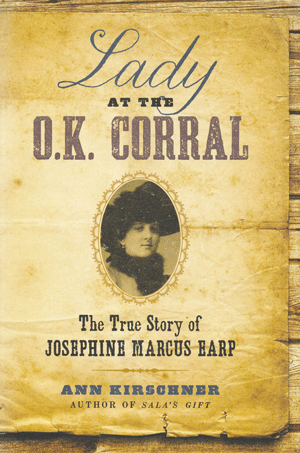Lady at the O.K. Corral: The True Story of Josephine Marcus Earp, by Ann Kirschner, Harper, 304 pages, $27.99
Reviewed by NEAL GENDLER
For 30 years after Wyatt Earp’s death, the location of his grave eluded the curious.
Apparently, no one thought to look in Hills of Eternity, a Jewish cemetery just outside San Francisco where his wife of 47 years had placed his ashes in her family’s plot.
A photo of the Earp headstone — Wyatt Berry Stapp next to Josephine Sarah Marcus — appears in Lady at the O.K. Corral, Ann Kirschner’s charming biography of Hyman and Sophia Marcus’ beautiful wild child. Only her name suggests anything Jewish, perhaps fittingly; Earp wasn’t Jewish, and Josephine, who didn’t deny being a Jew, was indifferent to it.
“Wyatt Earp had more Jewish friends than she did,” says Kirschner, a dean at City University of New York and author of Sala’s Gift. “Unlike her sisters, she chose a life of excitement over a home and children… The girl who ran away from home at 18 lived to be an old woman of 84 without ever having a single permanent address.”
Josephine drew her strength from Earp, “but she was the one who managed his business, signed his letters, and entertained his friends,” Kirschner says. “He was buried with tears and coast-to-coast headlines, while she died practically destitute and friendless.”
Her adventursome life crossed the American West from Tombstone, Ariz., where she met Earp, to Nome, Alaska, where they made their real money — $80,000, like $1 million now — in Wyatt’s co-ownership of an upscale saloon.
Josephine seldom appears in the many variations of the Earp legend, and “for more than 100 years, most of what was written about [her] was a lie — and no one told more whoppers about Josephine than she did herself,” Kirschner says.
Josephine sometimes claimed to come from wealthy German Jews, but her parents came from Prussian Posen, were more Polish than German, and her father began as a baker. She spoke with a Brooklyn accent from her four New York years and grew up with three siblings in San Francisco.
Enamored of the stage, she and a friend joined a traveling troupe performing HMS Pinafore in Arizona towns, reaching Tombstone in 1879. There, she met Deputy Sheriff Johnny Behan. The troupe disbanded in 1890, and Josephine went home. Behan persuaded her to return to Tombstone, where she lived with him as “Mrs. Behan” in the manner of other unmarried couples.
Kirschner quickly dispenses with the famous October 1881 shootout, but says Josephine heightened animosity between Earp and Behan, who’d defeated Earp to become sheriff. Earp and his brothers — one a deputy U.S. marshal — supported Tombstone’s calm-seeking townspeople against Behan’s ranchers and rowdy cowboy friends. Josephine returned home one day to find Behan with a woman, threw him out, and soon took up with tall, handsome Wyatt.
After Wyatt’s brother, Morgan Earp, was shot dead playing pool, Wyatt and supporters rode off after the killers; Josephine returned to San Francisco. Wyatt showed up there and the couple left for Utah.
Kirschner follows their wanderings in lively, clear language, telling of their love of the desert, her good cooking, and her conflicting desires for adventure and for status and respectability. Josephine claimed they married in 1888, but Kirschner says no record can be found. There is, however, a witness account of Wyatt with a kipa at a Marcus family seder.
Wyatt’s health slowly declined, and after his death in 1929, so did Josephine’s finances and status. Her well-off sister Hattie subsidized her. Josephine’s efforts to get a truthful book about their lives failed.
“Josephine would spend her last years with friends or in cheap rentals,” Kirschner says.
Afflicted with dementia that included paranoia and anger, Josephine died, ill and bitter, in 1944.
Lady is as engaging as a novel. A map plus 27 pages of tiny-type notes and bibliography show Kirschner’s enormous research to winnow fact from fiction and fill in huge blanks. She has provided a delightful, thoughtful account of a little-known woman who shared a half-century of devotion with a legend.
***
Neal Gendler is a Minneapolis writer and editor.
(American Jewish World, 3.15.13)




















